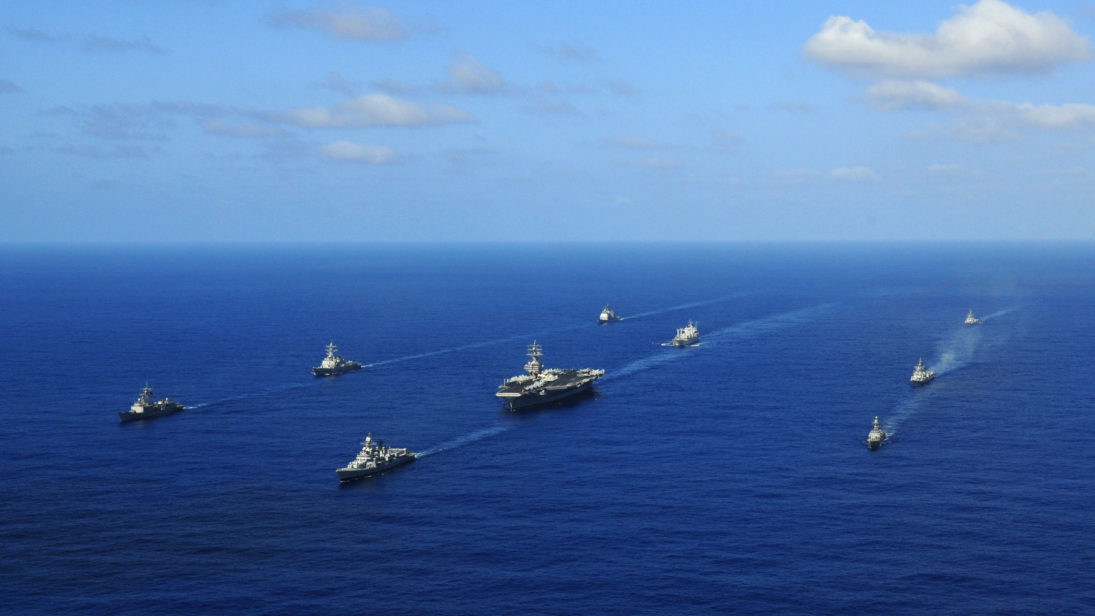
New Delhi’s role in the “Quad” grouping, made up of the United States, Japan, and Australia besides India, has been the subject of myriad debates recently. In a piece titled “Seven Myths are Keeping India and the United States from Pursuing Closer Ties,” Jeff M. Smith outlines several Indian misperceptions about the Indo-U.S. strategic relationship—and by extension with the Quad—that keep it from attaining its full potential to the benefit of both states. Smith views India’s engagement with the United States as that of a reluctant actor with an inertia-ridden foreign policy hesitating to take part in the extension of mutual security guarantees, which he regards as a key deliverable for the Quad. Dhruva Jaishankar, on the other hand, contends that the military component of the Quad exists in the mish-mash of trilateral and bilateral relationships that India and other countries in the grouping have cultivated.
Both assertions implicitly suggest that India necessarily needs the Quad to blunt the military balance that exists in favor of China. Instead, this piece argues that India’s vision of the Quad should be premised on the idea of attacking the foundation of Chinese maritime order in the Indo-Pacific, i.e. its infrastructure and investment in the region, rather than its military presence.
What Drives India’s Posture in the Indo-Pacific?
India and China both depend heavily on the sea lines of communication (SLOCs) in the Indian Ocean Region (IOR) and 95 percent of India’s trade by volume passes through it. Whereas India’s primary focus is on the IOR, it also has a secondary interest in the wider spans of the Indo-Pacific, such as in the South China Sea (SCS) and the Malacca Straits that carry 55 percent of India’s trade by volume and where India also has commercial oil and gas blocks.
The Indo-Pacific as a construct has different connotations for India depending on which side of the hyphenation one looks at. Although India has a developing interest in the SCS, it is still limited and India has signaled that it does not seek to be part of any military alliance in that region and would like to coordinate its actions with littoral states in the SCS to be part of a rules-based maritime order. Whereas in the IOR, New Delhi is engaged in myriad initiatives drawing in small, middle, and regional and extra-regional actors to form a cooperative cluster with India at its heart.
To protect its trade and energy flows, India has inked several logistics agreements that increase its capability in the IOR, allowing the Indian Navy to replenish stocks (such as food, fuel, and ammunition) and maintain an increased operational radius in the region for an extended duration of time. Other than having such reciprocal arrangements with the United States and France, India is in the process of establishing new coastal surveillance arrangements with littoral states in the IOR, which include Sri Lanka, Thailand, and Myanmar, adding to existing agreements with Singapore, Australia, Japan, and the Maldives.
Thus, India’s view of the Quad’s utility is more likely to be premised on how it can benefit India in its economic and security competition with China in the Indian Ocean rather than the Pacific.
India’s Conception of the Quad: An Investment Counterweight?
China seems to be following an economic-military strategy in the IOR, where security forces come into the picture to protect its commercial interests overseas. Thus, infrastructure and investment in the region justifies a security presence, such as through bases that serve as logistics and replenishment centers. For instance, one of the aims of China’s first overseas base, in Djibouti, is to ensure the protection of strategic seaways off the Horn of Africa that carry its trade and oil shipments. And although China claims that it has developed or has access to purely commercial ports in Pakistan, Bangladesh, Myanmar, and Sri Lanka, analysts fear that this infrastructure could be dual-use. Therefore, it may be wise to devise a strategy that seeks to hack at this foundation of Chinese maritime order in the IOR rather than to counter its military presence, which will merely address the symptom rather than the cause.
While India has been apprehensive of China’s growing military presence and growing hard-power capabilities in the IOR, India’s geographical location, extensive coastline, and control of island chains give it certain natural advantages over China, ensuring that the balance of power in the IOR resides in India’s favor. The Chinese are essentially operating thousands of miles away from their home waters and need replenishment for sustained deployments and though this is offset to a certain degree by Chinese bases in the IOR, these too are at a large distance from home and need to be restocked. In addition, despite the People’s Liberation Army-Navy (PLAN) augmenting its force structure and capability at an astounding pace, Chinese logistics and supply lines in the IOR remain fairly spread out and their ability to protect these bases when a crisis unfolds is doubtful. Chinese submarines that have entered the IOR have not been able to do so without being detected and tracked by the Indian Navy and since a submarine’s function is to counter an adversary’s sea-control ability, their detection effectively blunts the most lethal advantage that these platforms offer China in terms of stealth. The PLAN has also not operated an aircraft carrier in the IOR, which suggests that China may not yet have the offensive capability to control SLOCs in the region. Thus, to sum up, as Indian Naval Chief Sunil Lanba has said, India can match what the Chinese can bring to bear militarily in the IOR, at least at the moment.
However, as China continues to rapidly build dual-use infrastructure such as ports in the IOR that could potentially be used to project naval power in the future, India will need the help of the other members of the Quad to deal with this. To counter Chinese investments in the region, therefore, India needs the Quad to form a viable alternative to Chinese investments in the region by pooling in their political heft and economic resources. This would kill two birds with one stone: first, it would allow the Quad to stymie the growth of Chinese investments in the region, thereby limiting the buildup of a sustained Chinese naval presence in the IOR that may develop an offensive capability to control SLOCs at some point in future. Second, it would allow the Quad to project benign intentions by not having an outright military intent.
Conclusion
In sum, one can see why India needs the Quad to counter Chinese investments in the IOR before it can spawn an illiberal maritime order, while at the moment it does not need the Quad to externally balance China militarily. India does have a developing interest in the SCS, but its direct commercial interest is limited to Vietnam and it seeks to partner with ASEAN in taking a consensus-based instead of confrontation-based approach to address maritime security issues. The reluctance to extend mutual security guarantees is, therefore, a product of a pragmatic policy that sees no benefit in a military alliance in the IOR, mainly resulting from India’s historical misgivings about partnering with the United States militarily. The real strength of the Quad for India lies in its collective investment power and its potential to be an economic alternative to China for regional states. This can challenge the foundation of the maritime order Beijing seeks to establish.
Image 1: U.S. Navy photo by Mass Communication Specialist 3rd Class Dylan McCord via Flickr
Image 2: Raisina Dialogue via Twitter



